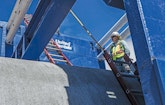
While trench boxes are not designed to prevent a trench wall from collapse, they are designed to protect workers from the lateral earth pressures and weight of the soils that exist in a trench or excavation.
Interested in Safety?
Get Safety articles, news and videos right in your inbox! Sign up now.
Safety + Get AlertsTrench work is inherently dangerous, but you can mitigate the risk.
Trench boxes are among the protective systems that can be used in trench and excavation projects to help keep workers safe and protected from cave-ins. Made from aluminum or steel, trench boxes are designed to protect workers from the lateral earth pressures and weight of the soils that exist in a trench or excavation.
While they are not designed to prevent a trench wall from collapse, when used appropriately, they can help protect workers from serious and sometimes fatal injuries if a cave-in occurs. But too often, workers misunderstand the right way to build and install a trench box, and some take shortcuts that put lives at risk. A seemingly small mistake with a trench box could have huge unforeseen consequences. When in doubt, crews should always turn to experts to help keep workers safe.
Here are eight tips to help avoid making a potentially serious safety mistake when using a trench box.
1. Don’t count on a trench box to prevent a cave-in. Remember that a trench box is a protective system designed to keep workers safe, not an active shoring designed to keep trench walls from collapsing. If a trench work site needs both worker protection and active shoring, contractors should use a system that applies a load to the trench wall greater than the earthen load coming from the trench wall. This may include hydraulic bracing systems.
2. Follow the manufacturer’s tabulated data. It is essential to use a trench box within its tabulated data. One common problem is using a trench box at a depth greater than the maximum depth it is rated for. Another is neglecting to build the box properly. The manufacturer’s tabulated data will help instruct the contractor on the allowable configuration, assembly and placement in a trench.
3. Watch the bottom. There have been work sites where crews place a box 3 feet off the bottom of a trench instead of the maximum 2 feet that OSHA regulations allow. If the box is more than 2 feet off the bottom, there is a risk of a cave-in from below. In addition, make sure the trench box is rated for the full depth of the trench.
4. Watch the top. If a contractor is using sloping in combination with a trench box, typically the top of the trench box must be at least 18 inches above the point where the soil intersects the shield. That 18 inches serves as roll-off protection, providing added guarding from falling or sliding materials or small equipment.
5. Replace any damaged spreader pipe or trench box panels. One of the responsibilities of a competent person at a trench project is to inspect all of the safety and shoring equipment that is being used. One of the many important shield components needing routine inspection is the spreader pipe. Often the spreader pipe can get bent or damaged, especially if an excavator lifts or moves the trench box using the spreader pipe instead of the actual lift points. Another condition that must be reviewed by the competent person is panel deflection. If the shield exhibits deflection on one of the trench box panels, it should be taken out for further inspection and possibly removed from service. In cases where there is potential or actual structural member damage to the shield, the manufacturer or engineer must be consulted for proper repairs to be made before putting it back into service.
6. Install panels or plates in the right place. If a contractor is using trench shield panels as end panels, always follow the engineering guidelines that address end protection. Do not place the panels directly against the spreader pipes. If there is a cave-in, the panels are intended to push against the end posts of the trench box, not against the spreader pipes, which could deflect, putting the protective system at risk. Per OSHA regulations, a shield system (trench box) must be deployed according to the manufacturer’s tabulated data or other tabulated data from a registered professional engineer. The end protection must also have similar tabulated data.
7. Stack with care. When stacking trench boxes, make sure the stacking pockets are lined up and the boxes are pinned together so the boxes can be properly secured vertically. If there are different thicknesses of trench boxes — say 4, 6 and 8 inches — the thinner trench boxes usually go on top of the thicker ones, but always refer to the manufacturer’s or professional engineer’s tabulated data.
8. Backfill the gap. By definition, a trench will always be wider than a trench shield placed within it. To eliminate the gap, backfill the void to stabilize the shield. Remember that the shield must always be situated so as to restrict lateral or other hazardous movement.
Shane Wareham is the director of sales and marketing at United Rentals.







